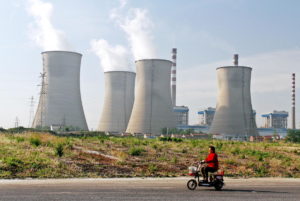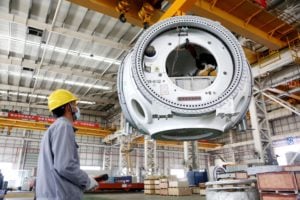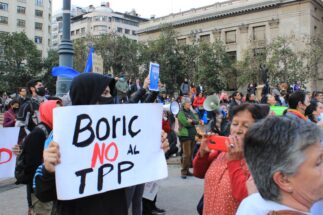Over 30 hydrogen filling stations, almost 1,000 hydrogen fuel cell vehicles providing the bulk of the transportation, and a hydrogen-fuelled Olympic torch. The widespread use of hydrogen at the 2022 Winter Olympics was designed to spur development of the sector in China.
In March, shortly after the Games ended, the central government issued its first medium- to long-term plan for the hydrogen sector, for the period up to 2035. The document put particular emphasis on the short-term use of “by-product hydrogen”, which is extracted from industrial waste gases rich in the element, by pressure swing adsorption or other techniques. Such hydrogen is to be given priority in parts of the country where coking, chlorine production and propane dehydrogenation is concentrated.
The plan set a target for 2025: having an initial hydrogen economy running, relying on local sources of by-product and renewable hydrogen.
The top-level policy design has prompted over 30 provincial administrations to produce their own plans and policy for hydrogen power. Shandong, Shanxi and Inner Mongolia have all said they will make use of local by-product hydrogen.
Such hydrogen is cheap and can help spur development of local hydrogen economies. But experts warn that China’s targets of peaking carbon before 2030 and reaching net zero by 2060 mean this cannot be the approach. There will have to be a rapid switch to renewable hydrogen, and so over-investment should be avoided.
Is hydrogen power green enough?
Using hydrogen power produces water but no carbon, making it clean and renewable. But manufacturing the gas is not necessarily carbon free. Hydrogen has various names depending on the carbon emissions incurred during its production. That produced from fossil fuels is known as grey hydrogen. When combined with carbon capture and storage (CSS), grey hydrogen becomes blue hydrogen. And when the gas is produced by renewable energy-powered electrolysis of water, it is known as green hydrogen.
China is the world’s biggest producer of hydrogen. Its output of 33 million tonnes a year is over one-third of the global total. Globally, 60% of all hydrogen is sourced from natural gas, 19% from coal, and 21% from industrial processes where hydrogen is a by-product. In China, coal is still the main source of the gas. It accounts for 62% of the country’s hydrogen output. Natural gas provides 19%, by-product hydrogen 18%, and electrolysis only 1%.
So hydrogen supplies both at home and overseas are not yet green enough. Cost and technology are the problem. According to a report from the Energy Transitions Commission, a kilogram of grey hydrogen costs between US$0.70 and $2.20, depending on the cost of natural gas and coal locally. Adding CCS technology for blue hydrogen is naturally more expensive again. The cleanest of all, green hydrogen, costs $3–5 a kilogram.
Some experts say green hydrogen is rapidly needed if hydrogen power is to support China’s dual carbon targets. Others see by-product hydrogen as an important stepping stone for the sector in the medium to long term.
As a major industrial power, China has plenty of raw material to work with. According to a white paper on its hydrogen and fuel cell industry, it costs 0.30–0.60 yuan (US$0.04–0.08) to extract a kilogram of hydrogen from industrial waste gases. Add in the costs of buying by-product gas, where that is necessary, and the overall cost of by-product hydrogen is in the region of 10–16 yuan (US$1.4–2.25) a kilogram.
By-product hydrogen is still “grey”, but it represents a more efficient use of resources than that produced directly from fossil fuels and to some extent helps reduce air pollution. According to the white paper, China’s coke oven gas, chlorine, synthetic ammonia, synthetic methanol and propane dehydrogenation industries can provide millions of tonnes of hydrogen – a cheap and widely distributed source of the gas which could help the industry grow.
The release of the national plan prompted local governments to speed up their hydrogen projects. According to the media, 18 hydrogen production projects got off the ground in the first half of this year, with an even split between by-product and renewable hydrogen. A look at the by-product projects underway shows that this will only be the first stage in developing the sector. The cheap hydrogen produced will allow the building of hydrogen power infrastructure in the surrounding area and nearby cities.
Using cheap hydrogen to build up the industry
The hydrogen industry chain runs through manufacturing, transportation, filling stations and fuel cells. The International Energy Agency has found developing a hydrogen sector needs efficient and cost-effective transportation and storage to link supply and demand and create a liquid market. China’s existing by-product hydrogen projects usually involve a filling station attached to the production facility, to supply local demand. Those filling stations are frequented by local hydrogen-powered vehicles and buses, as well as the heavy trucks used by local industry.
Early figures from Shandong indicate the province produces 2.6 million tonnes of hydrogen a year, more than any other province, most of which is the by-product variety. In 2021, Shandong’s first hydrogen “mother station” went into operation, at Taishan Steel. That facility can fuel almost 100 hydrogen-powered vehicles within a 150-kilometre radius. Its hydrogen comes from steel-making waste gases. The rollout of hydrogen filling stations has also led the Shandong Heavy Industry Group to put ten 49-tonne hydrogen fuel cell-powered cranes into use.
Wuhai in Inner Mongolia has taken a similar approach. By-product hydrogen from a Wuhai Chemicals chlorine plant is piped to a mother station in front of the facility. It is then sent onwards to hydrogen filling stations either by truck or pipeline, for use by the city’s 50 hydrogen fuel cell-powered buses. If the 80,000 diesel trucks and mining vehicles in the city could be converted to hydrogen fuel cells, there would be even greater scope for hydrogen take-up.
Infrastructure such as hydrogen filling stations are key parts of the hydrogen industrial chain – and in China, a weak link. As with hydrogen production, cost is hampering the building of more of those stations. According to data in the white paper, a filling station able to provide 500 kilograms of hydrogen a day costs about 12 million yuan (US$1.7 million) – three times the price of a normal filling station. There are also maintenance, operational and labour costs. Together, these have created a bottleneck in development of the sector. Overcoming these problems requires matching up supply of hydrogen and demand from hydrogen fuel cell vehicles. If there aren’t enough vehicles requiring hydrogen, the filing stations will not reach economies of scale and will be unprofitable.
In its report, the IEA said by-product hydrogen can provide a cheap source of the gas in industrial areas, where there are also hydrogen-powered trucks and buses serving local industries. That would maximise utilisation of the filling stations and resolve the main cost barriers to hydrogen rollout.
By-product hydrogen isn’t just cheap to make. Use near the point of production means transport and storage costs are also minimal. The white paper points out that a local hydrogen value chain can benefit from synergies. For example, hydrogen-powered truck fleets can operate more cheaply within an industrial cluster and its transportation corridors.
A project in Shanxi converting diesel vehicles to hydrogen ones is an example. The Shanxi Coking Coal Group can supply cheap hydrogen from its coking facilities. That is used to fuel trucks transporting coal – up to 2,200 of them, all operating at full load. One partner in the project is the State Power Investments Corporation. Its head of hydrogen business, Zhang Yinguang, said in an interview that coal mining areas have a huge and reliable demand for trucking. Thousands or even tens of thousands of hydrogen-fuelled trucks in an area would provide the economies of scale needed to bring costs down. And those trucks will be competitive with their diesel equivalents assuming hydrogen can be provided at 25 yuan ($3.51) a kilogram, or less.
Challenges abound
There is huge potential for by-product hydrogen to provide supply and spur development along the hydrogen chain. But there won’t be enough to meet sustained increase in demand, and difficulties with storage and transportation will remain. Also, excessive development of by-product hydrogen could risk locking in carbon-intensive infrastructure.
China’s dual carbon targets mean that output from the steel and chemical industries is bound to fall, in turn resulting in less by-product being produced, and so a crunch in supply of by-product hydrogen. Hebei is an example. There, work to meet the dual carbon markets will see the number of coking firms in the province drop to around 40 by 2025 – and so the output of waste gases available for hydrogen-making will drop from 940,000 tonnes a year to 450,000 tonnes.
Currently, most hydrogen filling stations rely on external supplies, delivered at high pressure. Delivery costs increase significantly if supply distances are over 200 kilometres. Local use is the key to success for by-product hydrogen, but not all industrial zones can follow the example set by the Shanxi Coal Coking Group. Unfortunately, there is little hope of a quick technical solution to high transportation costs.
Independent energy analyst Julien Armijo believes that by-product hydrogen from industrial processes based mostly on coal could present an opportunity in the short term, but over-reliance on it could be risky: investing in the wrong infrastructure could lock in carbon emissions. And if companies see it as an easy way to deploy hydrogen value chains, that could extend the life of carbon-intensive infrastructure that needs to be phased out.
Similar issues have been seen in other regions, especially Europe. The oil and gas sector often claims that blue hydrogen production can be quickly scaled up and should therefore be used as an interim solution until green hydrogen can be produced at scale. However, a report by E3G warns that such an approach may be counterproductive and again risk locking in high-carbon infrastructure and jobs, potentially hindering the development of green hydrogen.
Armijo holds the same view. “When companies invest heavily in building infrastructure, they usually expect it to run for decades or more before considering replacing or retiring it,” he says. E3G suggests that mechanisms will be needed to avoid a lock-in of fossil fuels and ensure a later switch to green hydrogen, including clear timelines and targets, accountability and transparency mechanisms, and regulations and standards which support the phase out. But Armijo is not optimistic: “Urgent action on climate change is needed but it is obvious that every government is acting much too slowly”.
Towards green hydrogen
A report by the Mercator Institute for China Studies (MERICS) pointed out that China’s near-term hydrogen policy focuses on “industry development first, greening second”. Compared to European strategies, which aim to leverage green hydrogen for rapid and deep decarbonisation, China’s policy remains conservative.
The good news is that green hydrogen costs have been falling and there is hope that it will become the main source of the gas. The ETC’s report predicts that green hydrogen will cost less than $2 a kilogram in most parts of the world by 2030. That will make it cheaper than either blue or grey hydrogen.
Alexander Brown, an analyst at MERICS, said industrial by-products provide a cheap source of hydrogen, but it is still grey hydrogen and has a significant carbon footprint. “Hydrogen can play an important role in achieving China’s dual carbon goals, but only with green hydrogen.” He believes that China cannot rely on industrial by-product hydrogen to meet growing demand: “If China is serious about its climate goals, it must turn to green hydrogen as soon as possible.”










